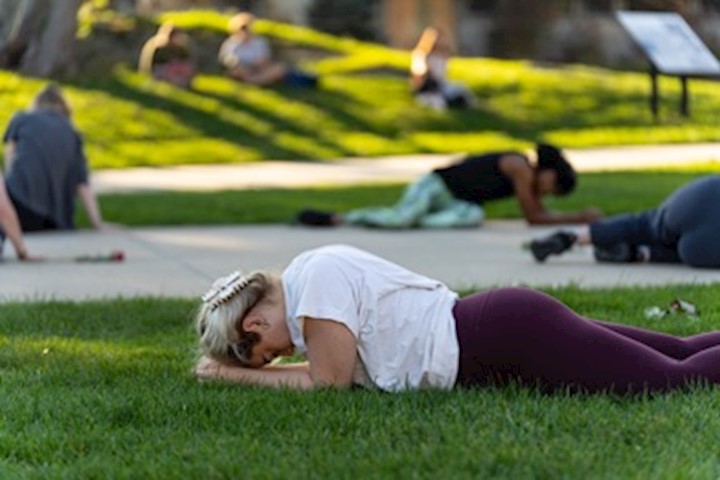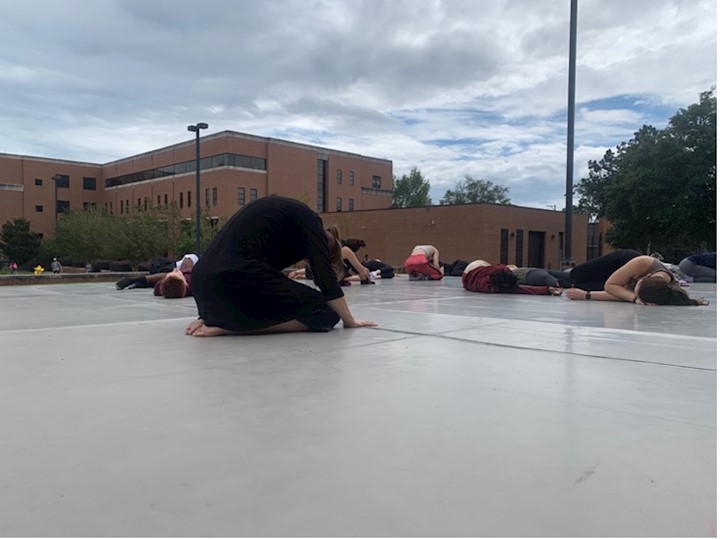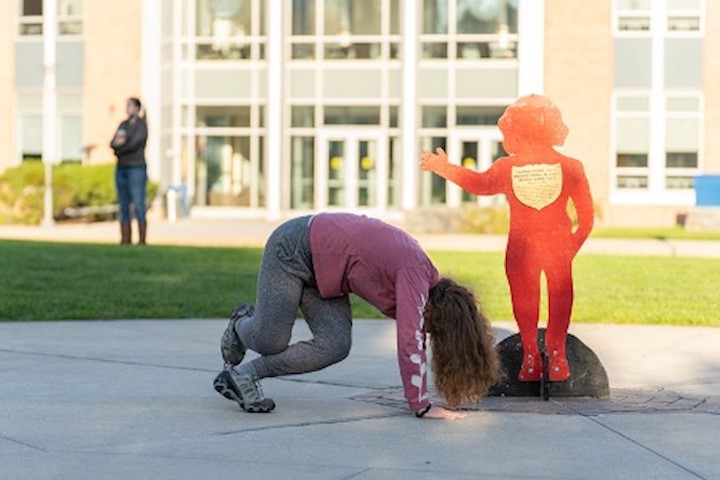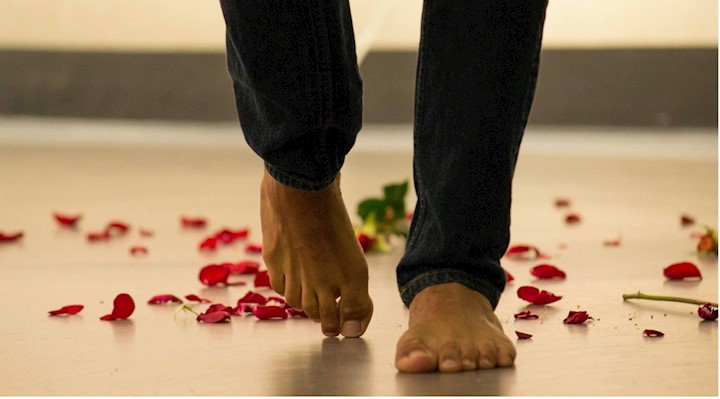
Abstract:
This article reflects on the STAND performance, an annual event to honor those who have experienced domestic violence that brings together groups of dancers locally, regionally, and nationally. Combining the embodied perspectives of two practitioners, it considers the communities created through these performances and the ways in which a seemingly simple action can inspire individual and communal transformation.
It’s cold here, the surface hard. My body contracts into a ball in response. Overtime I notice softness, waves, breath—my own measure of inner warmth. I learn where I yield, I meet myself, then find warmth. I recall a mentor telling me years ago that the Spring’s grass—new life in all its budding multiplicity—grows upward from below the frozen surfaces of winter long before we see it. The more I breathe into my body’s depth, the warmer I become. The impulse to start standing arrives.
In silence and stillness, we wait. A group of students and faculty occupy the common ground of an outdoor stage and the shared effort of taking one hour to move from the ground to standing. This impromptu community formed at The University of Southern Mississippi stands united with their peers 1,200 miles away at Roger Williams University in Rhode Island as well as dancers in Burlington at The University of Vermont. Created by RWU Dance Professor Cathy Nicoli, STAND is an annual performance event to honor those who have experienced domestic violence and brings together groups of dancers locally, regionally, and nationally. In the Fall of 2021, these combined efforts took on even greater significance, as lack of community—isolation through lockdown—has been cited in the rise of domestic violence accompanying the COVID-19 pandemic. UN Secretary General António Guterres expressed the concern felt around the world as, “We know lockdowns and quarantines are essential to suppressing COVID-19, but they can trap women with abusive partners,” such that, “as the economic and social pressures and fear have grown, we have seen a horrifying surge in domestic violence1 .” Although domestic violence does not exclusively impact women, even before the pandemic, 27% of women between the ages of 15 and 49 had experienced intimate partner violence2 . As both a human rights issue and a public health concern rooted in the body—and between bodies—domestic violence calls for bodies and dance practices to respond. Thus, STAND emerged from the resonance of lives and bodies impacted by such experiences and gestures towards the hope of individual and communal transformation.

Bones and soft body landmarks yield downward, anchoring through the grass. We resurface with reflections: I sink deeper backward and recall my mother telling me about the day I was born. She said I had the widest shoulders the doctors and nurses had ever seen—so wide they ripped her seemingly in half. I was tweezed out of my mother like a festering splinter, but still she remembers it being a moment of joy bypassing all pain. Her baby was screaming proof she had not miscarried this time, and to add to that, her baby girl had such wide shoulders she had been torn in half. At the time I had no idea how this resembled joy, but she continued to explain to me: little girls need wide shoulders for the weight they will carry as women.
Dancers participate as a group, enjoying the ensemble nature of the performance especially since many at first are intimidated by the task to which they are committing. This task requires successive motion—an attempt to continue the process toward STAND'ing, even when it is ever so subtle or increasingly difficult. One key result this continual effort provides is a heightened awareness of transitional moments as real, rather than as something unnoticed or devalued. In situations of domestic violence, sometimes change does happen overnight. By both practicing and acknowledging the potency of small movements and the strength required to accomplish them, we seek to affirm the struggles of everyone who has taken even small steps in their own healing.

Having reached a kneeling position, I find my fingers tracing the space in front of me at arm’s length. Gingerly they sink into the stage floor, sequentially leading to the downward press of my palm. The heat trace of my handprint on the ground reminds me of the size, or smallness, of me—as well as the potential for hands to extend both from the heart and from some less altruistic impulse.
During this year’s performance, the reauthorization of the Violence Against Women Act remained suspended in partisan politics, having been delayed for four years already. Yet, by the time we finished writing this reflection, senators had agreed to compromise on legislation for moving forward with the reauthorization, which includes increased support for preventative and educational measures on college campuses3 . In response to this forward movement, President Joe Biden noted that its provisions to protect and support those who have experienced domestic violence and other forms of violence against women are “a matter of justice and compassion4 .” Likewise, this performative action is one of justice and compassion—a gathering of dancers attempting to turn any stigma around domestic violence on its head.
Subtle shifts of weight reveal the bumpy terrain of my head as clear as a topographical map. Shoulder blades anchor my back and spine toward the floor. I have always imagined them as ancient wings, buried within the gristly archeology of my back. The act of raising one’s hand—to ask for help or to volunteer it—always seemed to me similar to a wing taking flight.
Through successive performances, we have learned to have an anchor witness—someone available to focus on safety of the performers as well as to communicate with audiences. Small signs or message boards silently offer passersby an opportunity to learn more about the performative action in which we are engaged, but such notification sits at the periphery of the space so as not to be invasively instructional. The performers themselves gradually transform into witnesses, as no one leaves until everyone has finished the process. During STAND performances, the act of witnessing (even from afar) offers a vital component of the community effort.

I continue spiraling, around and upward, upward and around…practicing how to stand again, now age 50. But for the rest of the hour, I can’t stop thinking that each shape my body makes is not only unfurling and opening into the world, but also carrying a lineage of invisible weights.
Both witnessing and enacting performance can offer healing for those who have experienced domestic violence. The movement created within individual bodies and through collective effort in STAND seeks to promote transformation not only for individuals but also for the fabric of our larger communities as, “Anthropologists, priests, folklorists, artists, and mental health professionals recognize that performance and ritual can create change, not just in the performer or the audience, but in the social relations that bind both audience and performer together5 .” Often STAND performances partner with Title IX offices, mental health advocates, domestic violence shelters, and even with the Silent Witness vigil—an initiative that acknowledges the names and stories of those who have lost their lives in domestic violence each year6 .
An accumulating crowd shuffles quietly onto the stage—these are not audience members but, rather, a growing number of performers and passersby inspired by the efforts of their peers and friends, who are now joining the cause.
With building momentum, dancers rise to their feet. Taking pleasure in the strength of their own bodies that carried them to standing, many of the performers now connect this vertical position to a renewal of hope for themselves and each other. As Danielle Wozniak and Karen Neuman Allen report from their own experiences leading performance processes for healing the trauma of domestic violence:
In order for the healing process to continue, women must continue to develop stories about themselves and the world around them founded on hope and possibility that can simultaneously compel them into the next stage and narrate it. This in turn creates a ‘community of memory’ that not only allows women to tell and hear other’s stories of healing and possibility but to participate with a community in co-creating life ways in which this healing is enacted7 .

Everyone stands rooted in place until the final dancer completes her ascent. This time spent moving has left its impression not only on individual consciousness but also on the group’s awareness of all its members. With imperceptible shifts, we begin to turn. Turning transforms into forward steps that carry us beyond this stage, beyond this moment—together.
If you would like to join the STAND community for the next performances, please contact Cathy Nicoli (cnicoli@rwu.edu) and Candice Salyers (Candice.Salyers@usm.edu).
1. Alex. R. Piquero, Wesley G. Jennings, Erin Jemison, Catherine Kaukinen, and Felicia Marie Knaul. “Domestic violence during the COVID-19 pandemic-Evidence from a systematic review and meta-analysis. Journal of Criminal Justice. 74 (2021). back to text
2. Lynnmarie Sardinha, Mathieu Maheu-Giroux, Heidi Stockl, Sarah Rachel Meyer, and Claudia Garcia-Moreno. “Global, regional, and national prevalence estimates of physical or sexual, or both intimate partner violence against women in 2018. The Lancet. 399 (2022). back to text
3. US Congress, Senate, Violence Against Women Reauthorization Act of 2022. S.3623, 117th Cong., 2nd sess., introduced in Senate February 9, 2022, https://www.congress.gov/117/bills/s3623/BILLS-117s3623pcs.pdf. back to text
4. Joe Biden. “Statement by President Biden on the Introduction of the Violence Against Women Act Reauthorization Act of 2022.” https://www.whitehouse.gov/briefing-room/statements-releases/2022/02/09/statement-by-president-biden-on-the-introduction-of-the-violence-against-women-act-reauthorization-act-of-2022. back to text
5. Danielle F. Wozniak and Karen Neuman Allen. “Ritual and Performance in Domestic Violence Healing: From Survivor to Thriver Through Rites of Passage.” Culture, Medicine, and Psychiatry. 36 (2012). back to text
6. “The Silent Witness National Initiative.” 2005. http://www.silentwitness.net. back to text
7. Wozniak. back to text
Works Cited
Biden, Joe. “Statement by President Biden on the Introduction of the Violence Against Women Act Reauthorization Act of 2022.” https://www.whitehouse.gov/briefing-room/statements-releases/2022/02/09/statement-by-president-biden-on-the-introduction-of-the-violence-against-women-act-reauthorization-act-of-2022.
Piquero, Alex. R., Wesley G. Jennings, Erin Jemison, Catherine Kaukinen, and Felicia Marie Knaul. “Domestic violence during the COVID-19 pandemic-Evidence from a systematic review and meta-analysis. Journal of Criminal Justice. 74 (2021).
Sardinha, Lynnmarie, Mathieu Maheu-Giroux, Heidi Stockl, Sarah Rachel Meyer, and Claudia Garcia-Moreno. “Global, regional, and national prevalence estimates of physical or sexual, or both intimate partner violence against women in 2018. The Lancet. 399 (2022).
“The Silent Witness National Initiative.” 2005. http://www.silentwitness.net.
US Congress, Senate, Violence Against Women Reauthorization Act of 2022. S.3623, 117th Cong., 2nd sess., introduced in Senate February 9, 2022, https://www.congress.gov/117/bills/s3623/BILLS-117s3623pcs.pdf.
Wozniak, Danielle F. and Karen Neuman Allen. “Ritual and Performance in Domestic Violence Healing: From Survivor to Thriver Through Rites of Passage.” Culture, Medicine, and Psychiatry. 36 (2012).